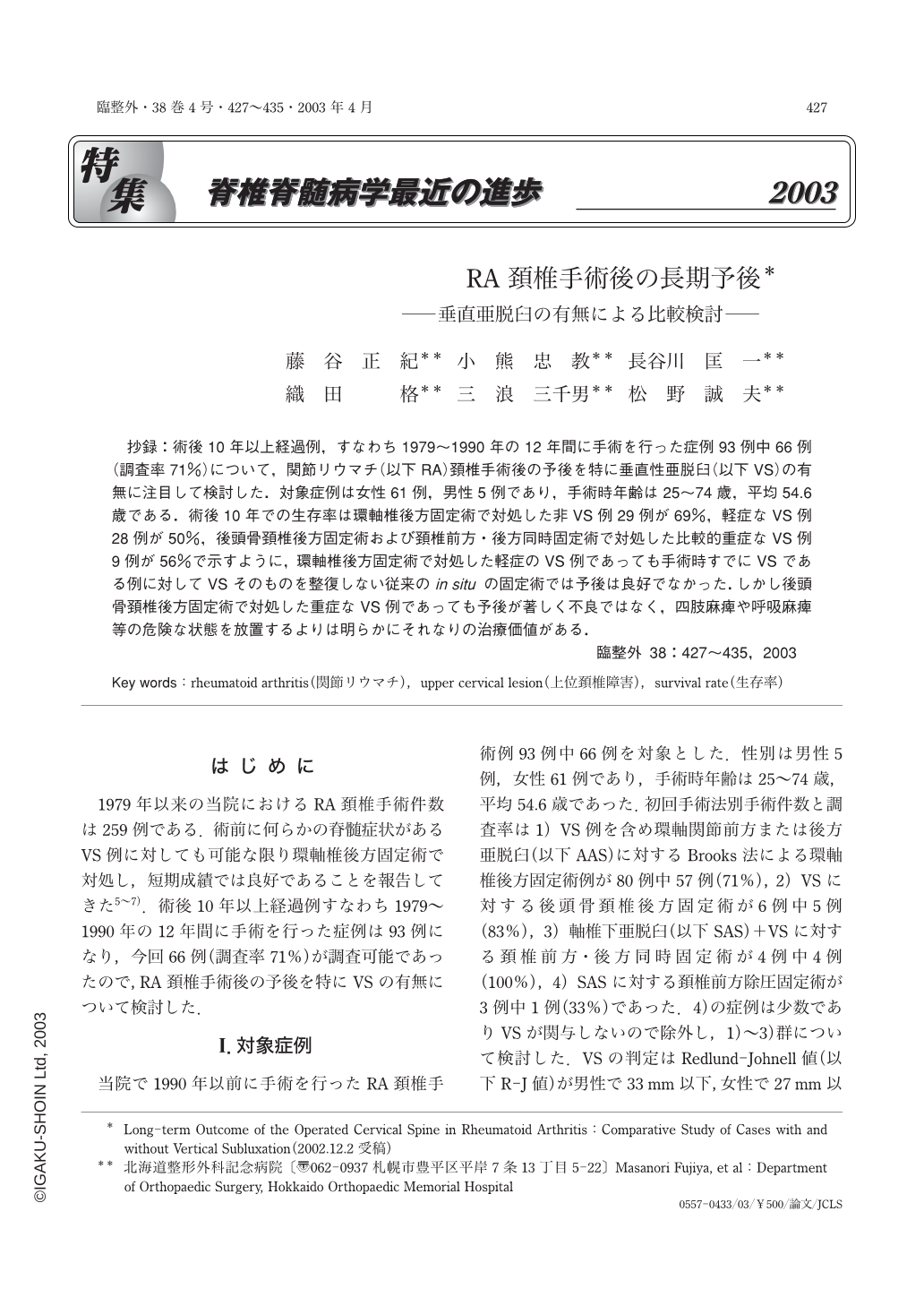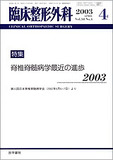Japanese
English
- 有料閲覧
- Abstract 文献概要
- 1ページ目 Look Inside
抄録:術後10年以上経過例,すなわち1979~1990年の12年間に手術を行った症例93例中66例(調査率71%)について,関節リウマチ(以下RA)頚椎手術後の予後を特に垂直性亜脱臼(以下VS)の有無に注目して検討した.対象症例は女性61例,男性5例であり,手術時年齢は25~74歳,平均54.6歳である.術後10年での生存率は環軸椎後方固定術で対処した非VS例29例が69%,軽症なVS例28例が50%,後頭骨頚椎後方固定術および頚椎前方・後方同時固定術で対処した比較的重症なVS例9例が56%で示すように,環軸椎後方固定術で対処した軽症のVS例であっても手術時すでにVSである例に対してVSそのものを整復しない従来のin situの固定術では予後は良好でなかった.しかし後頭骨頚椎後方固定術で対処した重症なVS例であっても予後が著しく不良ではなく,四肢麻痺や呼吸麻痺等の危険な状態を放置するよりは明らかにそれなりの治療価値がある.
Purpose:To investigate the long-term results of surgery on the cervical spine in rheumatoid arthritis and the patients' outcome.
Material and Methods:A total of 93 rheumatoid arthritis patients underwent cervical arthrodesis at Hokkaido Orthopaedic Memorial Hospital over a 12-year period (1979 to 1990), and 66 (71%) of them have been followed since their operation. Fifty-seven patients who had isolated atlantoaxial instability alone or in combination with mild vertical subluxation underwent atlantoaxial arthlodesis by Brooks' method. Anterior atlantoaxial subluxation or posterior atlantoaxial subluxation was present in 29 of these patients, and vertical subluxation was present in the other 28. Exclusive of the patients who were operated on twice, 5 patients with severe vertical subluxation had undergone posterior occipitocervical fusion, and 4 patients with severe vertical subluxation and subaxial subluxation had undergone combined anterior and posterior cervical fusion.
Results:The reduction after arthrodesis was maintained in the 57 patients who underwent atlantoaxial arthrodesis by Brooks' method. The average anterior atlas-dens interval had improved from 7.9mm to 1.6mm, and the average space available for the spinal cord had increased from 11.8mm to 16.2mm (excluding the 4 cases of posterior subluxation). Superior migration of the odontoid occurred in only 4 patients, and 2 patients required occipitocervical fusion as a second operative procedure. Subaxial subluxation occurred in 19 patients, and 7 patients required a second operative procedure because they developed a neurologic deficit. The reduction after arthrodesis was also maintained in the patients who underwent posterior occipitocervical fusion or combined anterior and posterior cervical fusion.
During the follow-up period 29 patients (44%) died (an average of 81months after surgery and at an average age of 62.7 years) and 20 of them had vertical subluxation. The 10-year postoperative survival rate of the 37 patients with vertical subluxation was 51%, as opposed to 69% among the 29 patients without vertical subluxation.
Conclusion:Early atlantoaxial arthrodesis seemed to prevent the development of vertical subluxation, because the reduction was maintained after arthrodesis in every case and postoperative progression of the vertical subluxation in the atlanto-occipital region was uncommon. However, patients with even a mild degree of vertical subluxation were at risk of dying in the early postoperative period.

Copyright © 2003, Igaku-Shoin Ltd. All rights reserved.


